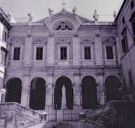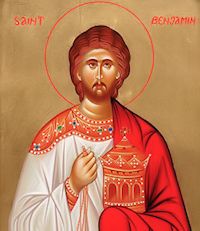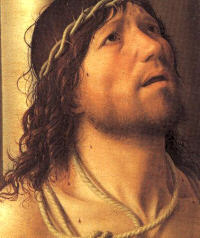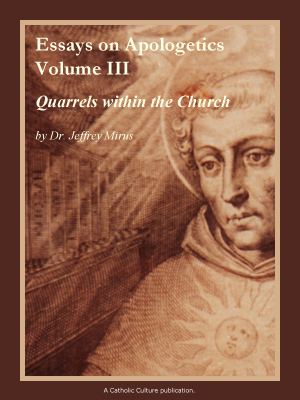Lent: March 31st
Friday of the Fourth Week of Lent
Other Commemorations: St. Benjamin, Deacon and Martyr (RM)
» Enjoy our Liturgical Seasons series of e-books!
Guided by the teachings of the Church through its admirable liturgy and the interior action of the Holy Spirit, souls ought to penetrate, to feel and almost to live, during these holy days, the unutterable sufferings of Jesus, immense as man's iniquity, the justice of God, and the love of His Heart. Souls ought to venerate and love that purity which impelled by divine love, is transformed into inconceivable pain for blotting out the sins of the world. —Liturgical Preludes, Most Reverend Luis M. Martinez, D.D.
| The Station is in the church of St. Eusebius, priest of Rome, who suffered for the faith in the Arian persecution under the emperor Constantius. |  |
Meditation - The Purity of Jesus
There is no purity like that of Jesus, and consequently, no horror for sin like His. The hatred for sin — which in God is infinite but without suffering — is immense in Jesus by reason of the hypostatic union; and on account of His human nature, so exquisitely sensitive to suffering, it is sorrow, bitterness and immolation.
Jesus' ineffable purity was in contact with sin for thirty-three years, not with one sin only but with all the sins of the whole world; not from afar, but closely united to them; not like something alien, but in a certain sense, as if those sins were His own; because ". . . the Lord hath laid on him the iniquities of us all." Who can comprehend the dreadful meaning of this Scriptural sentence? With even greater audacity, St. Paul says: "For our sakes he made him to be sin, who knew nothing of sin, so that in him we might become the justice of God."
That is, the purity of Jesus, totally foreign to sin, was laden by God with our sins so that we, sons of wrath, might be justified in Jesus.
But only God knows the immense horror, the unspeakable suffering and the indescribable confusion that this strange fellowship of sinlessness and sin produced in the Sacred Heart. The Scripture speaks of the sufferings that beset the holy Victim as "the sorrows of hell." Obviously infinite purity projected upon sin as justice and as hate produces hell; but when that ineffable purity contacted the world's sins to take them away, what could result but an abyss of suffering in Jesus' ever spotless soul?
What humiliation for Jesus to feel Himself responsible for all our iniquities! What a struggle in His Heart between love for His Father which made Him abhor sin, and love of mankind which impelled Him to cover our guilt with His perfection and His pain! Here is the secret of our Redemption as well as the mystery of its deepest dolors. Rightly did Jesus present to St. Margaret Mary Alacoque His thorn torn Heart wounded by a spear, surmounted by a cross!
Excerpted from Liturgical Preludes, Most Reverend Luis M. Martinez, D.D.
Things to Do:
- Today is a day of abstinence from meat. Try one of the meatless dishes for dinner tonight from our recipes section.
St. Benjamin
 The Christians in Persia had enjoyed twelve years of peace during the reign of Isdegerd, son of Sapor III, when in 420 it was disturbed by the indiscreet zeal of Abdas, a Christian Bishop who burned the Temple of Fire, the great sanctuary of the Persians. King Isdegerd threatened to destroy all the churches of the Christians unless the Bishop would rebuild it.
The Christians in Persia had enjoyed twelve years of peace during the reign of Isdegerd, son of Sapor III, when in 420 it was disturbed by the indiscreet zeal of Abdas, a Christian Bishop who burned the Temple of Fire, the great sanctuary of the Persians. King Isdegerd threatened to destroy all the churches of the Christians unless the Bishop would rebuild it.
As Abdas refused to comply, the threat was executed: the churches were demolished, Abdas himself was put to death, and a general persecution began which lasted forty years. Isdegerd died in 421, but his son and successor, Varanes, carried on the persecution with great fury. The Christians were submitted to the most cruel tortures.
Among those who suffered was St. Benjamin, a Deacon, who had been imprisoned a year for his Faith. At the end of this period, an ambassador of the Emperor of Constantinople obtained his release on condition that he would never speak to any of the courtiers about religion.
St. Benjamin, however, declared it was his duty to preach Christ and that he could not be silent. Although he had been liberated on the agreement made with the ambassador and the Persian authorities, he would not acquiesce in it, and neglected no opportunity of preaching. He was again apprehended and brought before the king. The tyrant ordered that reeds should be thrust in between his nails and his flesh and into all the tenderest parts of his body and then withdrawn. After this torture had been repeated several times, a knotted stake was inserted into his bowels to rend and tear him. The martyr expired in the most terrible agony about the year 424.
—Excerpted from Saints and Angels
Highlights and Things to Do:
- Read more about St. Benjamin:
- If you are named after St. Benjamin you can find a medal of him at the Catholic Company.
- St. Benjamin is also honored in the Eastern Orthodox Church and the Byzantine Rite Eastern Catholic Churches on October 13.






